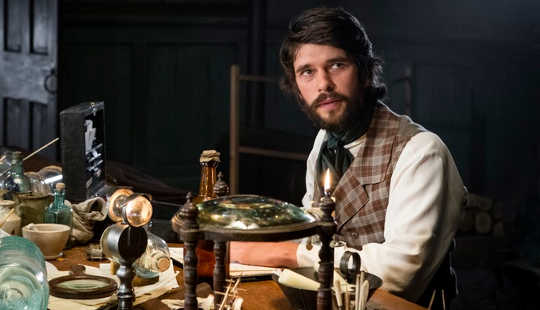 Ben Whishaw as Herman Melville. © Warner Brothers
Ben Whishaw as Herman Melville. © Warner Brothers
A man winds his way through the muck and mire of a 19th-century American port – Nantucket, centre of the world’s whaling industry. He knocks on a door, enters, and begs an exhausted looking man to tell him his story in exchange for his life savings. He’s heard rumours, he says, rumours about the 1820 sinking of the Essex, a whaling ship. The man – played by Ben Whishaw – turns out to be Herman Melville. He’s searching for the true story that will lead him to write Moby-Dick.
Ever since its publication in 1851, Moby-Dick has sparked the imagination with its prophetic, digressive and dangerous themes. So much so, it eclipsed the true story the novel is based on. But that real-life tale – that of a vengeful whale taking out a whaling ship – has now been adapted in true swashbuckling style by Ron Howard. The film, In the Heart of the Sea (released on Boxing Day), is based on Nathaniel Philbrick’s maritime history book of the same name.
The story goes like this. In 1819, the whale-ship Essex set sail from Nantucket. A year into the voyage, 2,000 nautical miles (3,700 km) west of South America, a pod of whales was sighted by the lookout. The harpoonists set out in their small whale boats to reap their bounty.
But one of those small boats – that of first mate Owen Chase – was smashed to pieces by a whale’s tail. The crew returned to the Essex, whereupon, according to Chase, they saw “a large spermacetti whale about 85ft in length heading directly for them as if fired with revenge”.
The whale struck the Essex. And when it rammed the ship a second time, it was obvious that it would sink. The remaining crew of 20 men, thousands of miles from land, salvaged what supplies they could and set off in three small cedar boats.
Thus began an incredible tale of maritime survival. The men spent over three months at sea and had to resort to cannibalism in order to survive. Captain Pollard and Charles Ramsdell were discovered gnawing on the bones of their shipmates in one boat. Owen Chase, Lawrence and Nickerson also survived to tell the tale. In all, seven sailors were consumed.
Moby Doll
For several years now, the whale – and in particular the white whale, the ambiguous, mythical Moby-Dick – has been a recurring anchor for my own art work.
The relationship between humans and cetaceans has long been something of a paradox. We are drawn to their mystery and intelligence, in awe of their size and grace, yet we hunted many whales to near extinction, and still today use dolphins and orca for military manoeuvres and entertainment. The most likely reason that the historical whale turned on the Essex was not revenge, but self-defence. Perhaps it was protecting the calves that were routinely slaughtered to attract their oil rich mothers to their untimely demise.
Owen Chase’s first hand account of the whale describes it as male, and this has determined the way most accounts speak of the incident. But of course there’s at least a 50% per cent chance that the whale that attacked the boat was female. Sperm whales are matriarchal, they form strong social groups, babysit and suckle each other’s calves and act collectively to protect their young. If threatened, several females will form what is know as a marguerite pattern (daisy) around a young whale in need of protection to fend off attack. Bull whales, meanwhile, are solitary and leave the pod at maturity, returning only to mate.
Whale Oil
The whale of both In the Heart of the Sea and Moby-Dick is a charismatic beast; seeming to signify many contemporary themes – capitalism, religion, colonialism, morality, ecology, racism. The whale, like the canary in the mine, is also an ecological barometer. In our pursuit and dominion over nature, we expose our own flaws and vulnerability.
In pursuit of whale oil, these unfortunate mariners crossed the unutterable taboo of cannibalism (ironically, once adrift they voted against trying to head west to the nearest islands, the Marquesas, due to rumours of cannibalistic inhabitants). And while the good Quaker folk of Nantucket fought for the abolition of slavery, they also continued to pursue the noble domestication of the savages encountered on whaling voyages. Placing missionaries among cannibals they asked them to “eat” the flesh and drink the “blood” of a new god.
The whales that the men of Nantucket were at sea brutally harvesting were one of the first global commodities. Their oil illuminated and lubricated the Industrial Revolution, generating vast fortunes. Hunting down these creatures for fuel may seem archaic today, but it was the historical version of coal or gas, crucial to the world economy. Towards the end of the film the old Thomas Nickerson says, “I hear someone’s found oil by drilling into the ground. Who’d have thought!”
Our pursuit of the highly intelligent whale, a creature that has roamed the ocean for 60 million years and which we have persecuted almost to extinction, says much about our own species. We should remember this when considering our continued penchant for fossil fuels.
That 19th century whale oil has lubricated our own voyage through an imagined and uncharted space that traverses land and sea, ocean floor to outer space. So when you watch In the Heart of the Sea, consider how it reflects upon our own behaviour in our continuing quest for dominion over nature and resource.
About The Author
 Angela Cockayne, Reader in Art and Design, Bath Spa University. Her books include Provenance 2010 and Dominion 2011 both co authored with Philip Hoare. Published by Wunderkammer Press. She is also co-curator of the www.mobydickbigread.com
Angela Cockayne, Reader in Art and Design, Bath Spa University. Her books include Provenance 2010 and Dominion 2011 both co authored with Philip Hoare. Published by Wunderkammer Press. She is also co-curator of the www.mobydickbigread.com
This article was originally published on The Conversation. Read the original article.
Related Book:
at InnerSelf Market and Amazon























